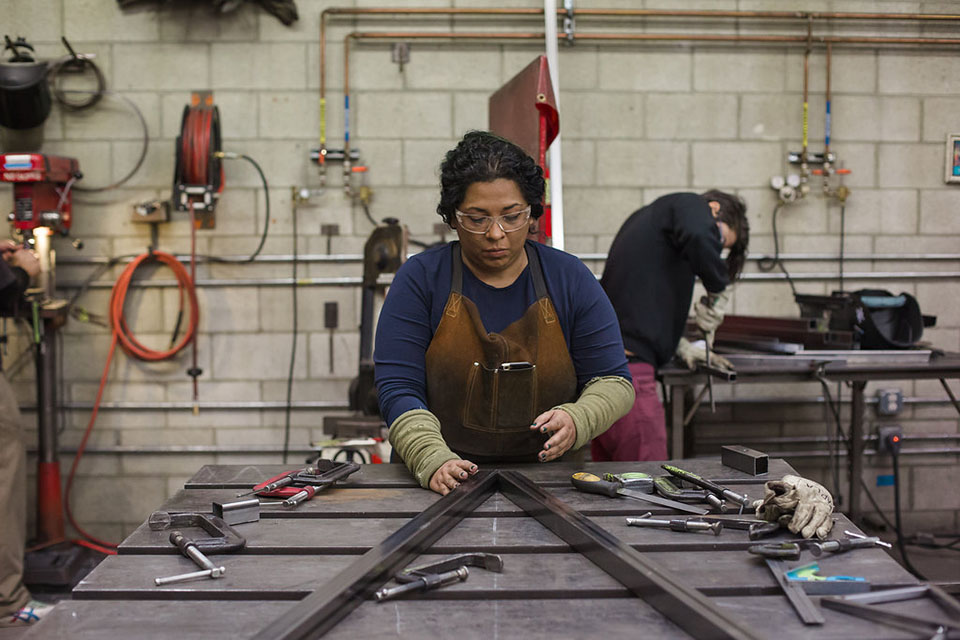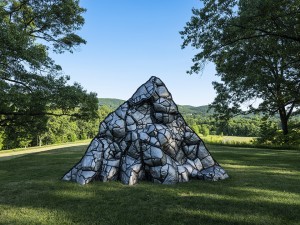CSUN’s Beatriz Cortez Named a Latinx Artist Fellow

Beatriz Cortez working on a sculpture. Photo courtesy of Gina Clyne and Clockshop.
The call came out of the blue, and took California State University, Northridge Central American and transborder studies professor Beatriz Cortez by surprise.
The person at the other end informed her that she had been named a Latinx Artist Fellow by the U.S. Latinx Art Forum. The honor came with an unrestricted $50,000 award to support her work as an interdisciplinary artist and sculptor.
“It was unexpected,” Cortez said. “When they told me I had been named a Latinx Artist Fellow, I was amazed. The money will allow me to make more art. I am in the company of people I have admired so much for so long — artists who have worked so hard to give visibility to Latinx people and their different cultural background. I am so honored.”

Beatriz Cortez’s “Ilopango, the Volcano that Left,” installed at Storm King Art Center, Mountainville, NY. Courtesy of the artist and Commonwealth and Council. Photo by Jeffrey Jenkins
The U.S. Latinx Art Forum was founded in 2015 to support the creation of a more equitable art world by championing artists and arts professionals dedicated to Latinx art through research, studio practice, pedagogy and writing. Three years ago, the organization launched the Latinx Artist Fellowship to provide direct support to artists.
Cortez is one of 15 members of the fellowship’s newest cohort. The other Latinx Artist Fellows are visual artist Felipe Baeza; arteologist and multimedia artist Diógenes Ballester; interdisciplinary and social practice artist Margarita Cabrera; visual artist Sofía Gallisá Muriente; multidisciplinary artist Verónica Gaona; printmaker, painter and mixed media artist Ester Hernandez; interdisciplinary visual artist Joiri Minaya; interdisciplinary mixed media artist Raphael Montañez Ortiz; sound, installation and performance artists Postcommodity (Cristóbal Martínez and Kade L. Twist); visual artist Daisy Quezada Ureña; photographer Diana Solís; interdisciplinary visual and public artist Edra Soto; multidisciplinary artist Maria Cristina (Tina) Tavera; and interdisciplinary artist Mario Ybarra, Jr.
A jury of curators at the forum’s partner organizations, current fellows and arts practitioners selected the cohort from more than 200 nominations recommended by invited external nominators with Latinx art expertise.
“Like our first two cohorts, these 15 extraordinary artists embody the originality and talent that abound within that Latinx artistic community,” said Adriana Zavala, executive director of the U.S. Latinx Art Forum, when the announcement about the 2023 fellows was made last week.
Cortez is chair and a founding faculty member of CSUN’s Department of Central American and Transborder Studies, the only such program in the country, and teaches in the College of Humanities.
As an academic, she specializes in contemporary Central American literatures and cultures from interdisciplinary perspectives, the construction of memory and the imaginaries of the future. She is the author of “Aesthetics of Cynicism: Central American Post War Fiction” and is co-editor of the third volume of the series “Towards a History of Central American Literature,” titled “Perversions of Modernity: Literatures, Modernities, Displacements.” She is co-author of “Introduction to Central American Studies” and the author of numerous essays on postwar Central American literature and culture.
As an artist, Cortez’s work explores simultaneity, the existence in different temporalities and different versions of modernity, particularly in relation to memory and loss in the aftermath of war and the experience of migration, and in relation to imagining possible futures.
She has had solo exhibitions throughout the United States and across Latin America. Her most recent work — three site-specific sculptures that consider the experience of migration through the lens of simultaneity, recalling multiple spatial and temporal realities that immigrants experience at once — is currently on display through Nov. 13 at the Storm King Art Center in New York’s Hudson Valley. Storm King is the world’s leading museum for modern and contemporary outdoor sculpture. She also currently has a solo exhibition, “The Portals,” at Williams College’s Museum of Art in Massachusetts.
Cortez said her art is, in a way, an extension of what she teaches in her classroom.
“Art is an amazing interdisciplinary medium through which you can help people understand new concepts and ideas,” she said. “It’s a way to get people to think about what it means to be a human being, to imagine other possibilities and experiences, to see beyond their own communities and gain knowledge from the experiences of others that is embedded in the artwork. Art is a way of bringing the voices of those usually kept outside of our spaces to the table.”

 experience
experience